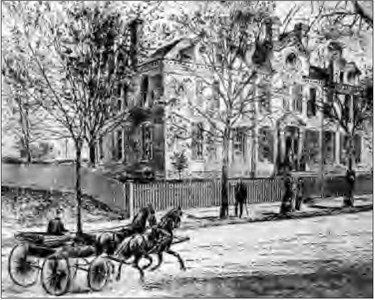Blessing opened with one doctor 140 years ago

The year 2015 is one of celebration for Quincy as it includes the 175th anniversary of Quincy and the 140th anniversary of Blessing Hospital. Founded in 1825, the village had its first health crisis, a cholera epidemic, before it was incorporated as a city in 1840. The community worked together through the epidemic and continued working to improve the health and sanitation of the town.
The first doctor, Thomas Baker, arrived in 1824. He didn’t stay long. By 1849, there were 50 doctors in the area. In the early years, the community experienced epidemics and diseases of every kind. Unfortunately, doctors’ knowledge of the causes of disease was limited, recovery depending more on the overall health of the patient than the available drugs or surgical solutions. There was no hospital by the time of the Civil War, but five hospitals for the wounded Union soldiers opened.
Those years and the decade after saw tremendous growth for Quincy.
Those who could afford a doctor were cared for at home. Those who could not were sent to the city poorhouse and infirmary.
Father Schaefermeyer of St. Boniface Church was dissatisfied with the care at the infirmary and was instrumental in establishing St. Mary Hospital in 1867.
Those who organized and incorporated the Charitable Aid and Hospital Association in 1873 thought that one hospital was not enough for a growing community and opened Blessing Hospital in 1875 with 12 rooms, one doctor and one matron.
The Archive at Blessing Hospital has a ledger from October 1875 to April 1876 that contains notes on 144 visits.
These notes show that many people had no defined idea of hospitals or hospital care. They would come to the matron asking for money, food, transportation chits or a place to stay. Her notes were frank and often judgmental.
“October 22, 1875, V.G.R. came here from Olena, Henderson County. Goes about on crutches, draws a pension … spends his time in saloons. Evidently a dead beat. Says he wants money to go home.”
“December 27, 1875, W. A. … has been sick 3 months … has wife only at home … had better be sent to hospital [but he doesn’t] want to go to hospital … Mrs. A says she only wants a little sugar and coffee.”
“April 3, 1976, J.P., a young man … says he came here from Mississippi on Saturday last … yesterday he went on board a steamer to go to Keokuk … was drunk and had some difficulty with the mate of the boat who struck him with a handspike, giving him a severe wound in the head and hurting his side … he has no means …sent him to Blessing Hospital.”
The difficulties of running the hospital became taxing for the board of trustees. A letter written by William Bull, secretary of the Charitable Aid and Hospital Association, dated Feb. 9, 1878, says: “The Trustees own the Blessing Hospital property, which is new and unencumbered with debt. They wish to have the management of the Hospital assumed by ladies believing that such a management will meet with the best results.” The letter invited 31 prominent Quincy and Adams County women to form a Board of Lady Managers. The trustees would manage the building, grounds and finances while the Lady Managers would supervise the hospital.
Their duties included fundraising, buying and distributing supplies, inspecting the facility, hiring the staff, deciding who could be admitted and discussing the care of the patient. At the first meeting, they established rules for the hospital and elected Sarah Denman as president. After only a few months, they hired a trained nurse to be the hospital superintendent.
Unfortunately she did not stay long, causing the women to lament in their minutes about the difficulties of managing a hospital without a trained nurse.
During their first year as managers, they met with the Adams County Medical Society and asked it to nominate seven doctors to serve as a medical board who would then appoint three of their group to visit the patients daily.
The Lady Manager minutes from those early years are full of concerns about costs, suggestions for fundraising and the problems of retaining a professional staff. Nothing was too inconsequential for the women to discuss.
In the July 3, 1878, minutes, “Mrs. H. stated that the institution was to have the use of a cow as soon as suitable quarters could be provided for her; that some of the materials and labor for building a shed had been already donated and that a few chickens would meet a cordial reception.”
In those same minutes, they mentioned the lawn party held by Mrs. Burt, which raised $38.43.
In April, 1879, “Mrs. Marsh spoke of the advantage of wire screens for windows for the coming summer,” … a committee was formed “to ascertain whether wire screens could be procured on terms sufficiently favorable to justify the luxury.”
In their Dec. 1, 1879, minutes, the women expressed concern about the $25 cost of drugs per patient, saying they “have no desire to dictate to the Medical Board concerning its expenditure but aim … to exercise the judicious economy which a narrow and uncertain income demands.
They respectfully invite the cooperation of the Medical Board in securing this end and will gladly welcome any suggestions from them.”
From such small and economically fragile conditions, Blessing Hospital grew to become Blessing Health System and the community health leader it is today.
Arlis Dittmer is a retired medical librarian. During her 26 years with Blessing Health System, she became interested in medical and nursing history — both topics frequently overlooked in history.






